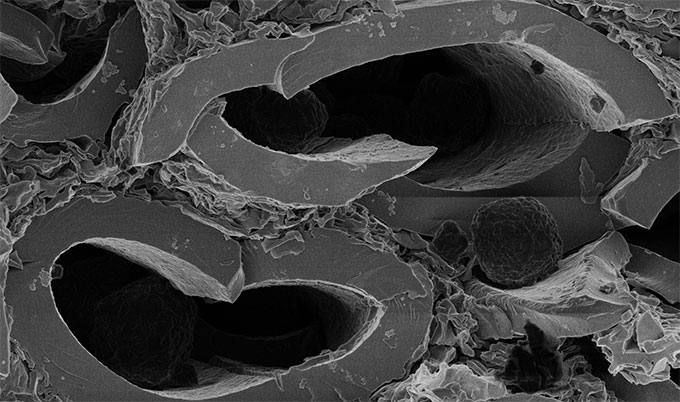Comment: Peter Cumpson mega microscope
Comment: Microbe traces in ancient rocks could help find life on Mars
Published on: 13 October 2016
Writing for The Conversation, Professor Peter Cumpson discusses new techniques that could detect traces of past microbial life in meteorites from Mars.

One of the most tantalising questions in science is whether there is or ever has been life on Mars, at least in microbial form. But despite plenty of effort – including orbiting missions and even rovers that have analysed its red rocks and soil – we have so far not managed to detect any conclusively.
Now we have new techniques that could actually detect traces of past microbial life in meteorites from Mars here on Earth. We know the method itself works: we have used it to detect traces of ancient life in basalt rocks on Earth for the first time. And the best thing about it is that these rocks are very similar to those found on Mars.
The importance of surfaces
Surfaces are key to this. It may seem like we live in three dimensions but I’d like to argue that we mostly live in two. Almost all the objects we see (except glass, some plastics and the occasional crystal) are opaque, so we only see and interact with the surface. Life is, in many ways, a surface effect.
Things grow on the surface of my coffee cup in my office over the weekend. Occasionally, I’ll give it a rub (on the surface) to clean it up a bit, but I need a cloth with the right type of surface to do it. In more serious biological and medical cases surfaces are critical. Antibiotic and antifungal medicines largely work by disrupting the surfaces of bacteria and fungi. The NHS spends an enormous amount each year replacing catheters when things grow on their surfaces. The list goes on. Surfaces matter.
Some of the earliest forms of life on our planet were forced to make their own surfaces to live on. It was by looking at surfaces from samples of basalt rock from hundreds of metres under the floor of the Pacific Ocean that we managed to discover organic compounds deposited around microscopic “tunnels”.
We think the tunnels in these 220 million-year-old rocks have been left by the finger-like branching filaments of fungi, possibly to find nutrients or seek protection from predators. Similar structures have been seen in 3.3 billion year-old rocks, which could make them evidence of some of the earliest life on Earth.
Next steps
The research suggests that these microbe-made surfaces may be a good place to begin looking for life elsewhere. While we are not sure exactly how long the traces of biomolecules survive, we know that some are extremely robust. It is increasingly clear from looking at fossils, for example, that tenacious molecules like melanin can remain for hundreds of millions of years and give a clue to the colouring of dinosaurs.
It may therefore be possible that molecules that are even more simple and robust than melanin, such hopanes or sterains, could remain in Martian meteorites – small fragments of rock that were blasted from the surface of Mars when a large meteorite smashed into Mars in the distant past, and which then made the long and random journey to fall to the surface of the Earth. The likelihood is that at least some of the most robust organic molecules would survive the extremely rough treatment of even two meteorite impact events.

We have only just started to look at such fragments. We don’t need much – a few pieces just a few millimetres in size are a good start. These are the only bits of Mars we can take a look at right now, and a careful investigation of their surfaces may be very revealing.
We don’t know exactly how long the job will take – it is a tough task. If we simply look at those surfaces with a powerful microscope we may see features that look like they have been left by microbes – but there is certain to be a geological and lifeless explanation for those, too. And if we instead put a bit of the Martian meteorite in a blender and then analyse it by conventional chemical analysis methods, we might find the molecules of life – but hey, those could be surface contamination from after it hit the ground.
We therefore hope to confidently and accurately locate biological molecules – signs of life – within features that look like they have been made by life, like the tunnels we see from microbes on Earth, for example. If those biomolecules are there – and not anywhere else in the sample – then I think we have nailed it.
The techniques we use include X-ray photoelectron spectroscopy (XPS) and a Secondary Ion Mass Spectrometry (SIMS) that image the surface chemistry. This works by focusing electrons, ions (atoms that have lost electrons) or X-rays onto the surface and looking at the particles that emerge after these beams have hit it. This lets us map very low concentrations of elements and molecules on the surface of a sample, often at the scale of tens or hundreds of nanometres, which gives us images of where specific molecules lie.
Beyond the issue of life on Mars, these instruments also help us to look at surfaces for a whole range of medical, physical and engineering problems. It’s a great help to those of us who live in two dimensions.
Peter Cumpson, Professor of mechanical engineering, Newcastle University
This article was originally published on The Conversation. Read the original article.



